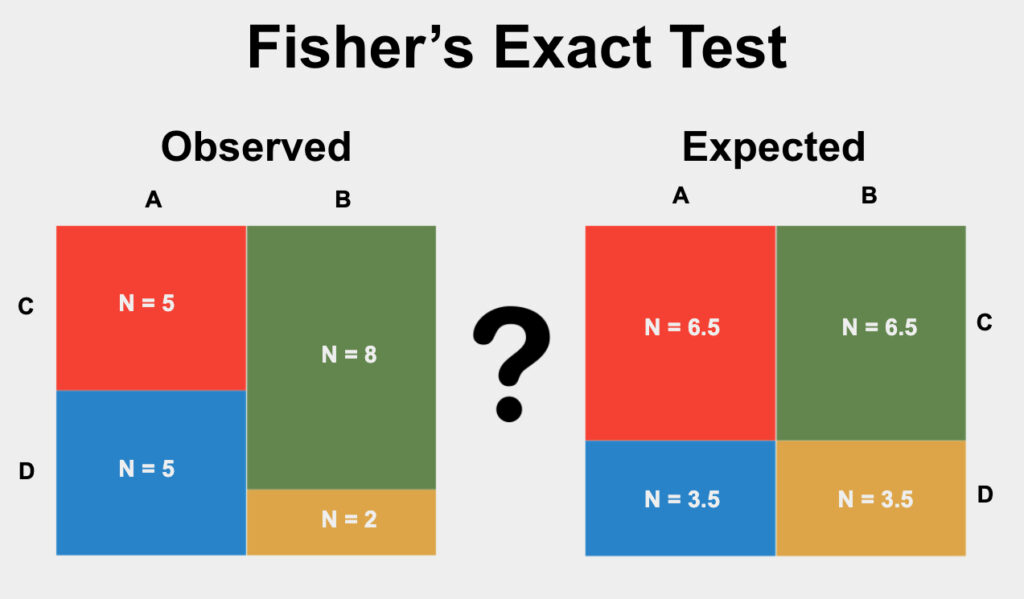The StatsTest Flow: Difference >> Proportional or Categorical >> Two Group Variables >> Two Options >> Independent Samples >> Less Than 10 In a Cell
Not sure this is the right statistical method? Use the Choose Your StatsTest workflow to select the right method.
What is Fisher’s Exact Test?
Fisher’s Exact Test is a statistical test used to determine if the proportions of categories in two group variables significantly differ from each other. To use this test, you should have two group variables with two or more options and you should have fewer than 10 values per cell. See more below.

Fisher’s Exact Test is also called the Fisher Irwin Test, Fisher’s Exact Test of Independence, Fisher’s Test.
Assumptions for Fisher’s Exact Test
Every statistical method has assumptions. Assumptions mean that your data must satisfy certain properties in order for statistical method results to be accurate.
The assumptions for Fisher’s Exact Test include:
- Random Sample
- Independence
- Mutually exclusive groups
Let’s dive into what that means.
Random Sample
The data points for each group in your analysis must have come from a simple random sample. This is important because if your groups were not randomly determined then your analysis will be incorrect. In statistical terms this is called bias, or a tendency to have incorrect results because of bad data.
Independence
Each of your observations (data points) should be independent. This means that each value of your variables doesn’t “depend” on any of the others. For example, this assumption is usually violated when there are multiple data points over time from the same unit of observation (e.g. subject/customer/store), because the data points from the same unit of observation are likely to be related or affect one another.
Mutually Exclusive Groups
The two groups of your categorical variable should be mutually exclusive. For example, if your categorical variable is hungry (yes/no), then your groups are mutually exclusive, because one person cannot belong to both groups at once.
When to use Fisher’s Exact Test?
You should use Fisher’s Exact Test in the following scenario:
- You want to test the difference between two variables
- Your variable of interest is proportional or categorical
- You have only two options
- You have independent samples
- You have less than 10 in a cell
Let’s clarify these to help you know when to use Fisher’s Exact Test.
Difference
You are looking for a statistical test to look at how a variable differs between two groups. Other types of analyses include testing for a relationship between two variables or predicting one variable using another variable (prediction).
Proportional or Categorical
For this test, your variable of interest must be proportional or categorical. A categorical variable is a variable that contains categories without a natural order. Examples of categorical variables are eye color, city of residence, type of dog, etc. Proportional variables are derived from categorical variables, for instance: the number of people that converted on two different versions of your website (10% vs 15%), percentages, the number of people who voted vs people who did not vote, the proportion of plants that died vs survived an experimental treatment, etc.
If you want to compare two continuous variables, you may want to use an Independent Samples T-Test.
Two Options
Your categorical variables should have only two possible options. Some examples of variables like this are made a purchase (yes/no), color (if just black/white), recovered from disease (yes/no).
Independent Samples
Independent samples means that your two groups are not related in any way. For example, repeated measurements from the same group over time are often not independent samples, because each observation from the same person is likely related to other samples from that person.
If you have repeated measures from a single sample, you should consider using the McNemar Test.
Less than 10 in a Cell
The rule-of-thumb we recommend is to use this test when you have around 10 or fewer observations in each cell. “Cell” in this case refers simply to the count of values in each group. For example, if I have a list of survey responses with 5 “yes” and 1 “no”, there are 5 and 1 value(s) per cell, respectively.
If you have more than 10 in a cell, we recommend using the Two-Proportion Z-Test. And if you have more than 10 in every cell and more than 1000 total observations, we recommend using the G-Test.
Fisher’s Exact Test Example
Group: Treatment (A/B)
Variable: Recovered from disease (yes/no)
In this example, we are interested in investigating whether our two treatment groups differ significantly in rate of recovery from disease. The null hypothesis is that there is no difference between recovery rates between the two groups.
Because our variable is binary with only two possible values (yes/no), and our data meet all other assumptions, we know that Fisher’s Exact Test is appropriate to use here.
The analysis will result in a probability or p-value. The p-value represents the chance of seeing our results if there was actually no difference in recovery rate between the two treatment types. A p-value less than or equal to 0.05 means that our result is statistically significant and we can trust that the difference is not due to chance alone.
Frequently Asked Questions
Q: How do I run Fisher’s Exact Test in R?
A: StatsTest is focused on helping you pick the right statistical method every time. There are many resources available to help you figure out how to run this method with your data:
R article: https://towardsdatascience.com/fishers-exact-test-in-r-independence-test-for-a-small-sample-56965db48e87
R video: https://www.youtube.com/watch?v=POiHEJqmiC0
Help!
If you still can’t figure something out, feel free to reach out.